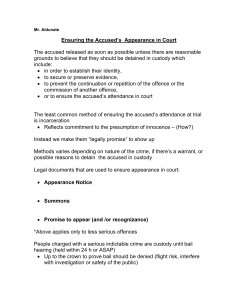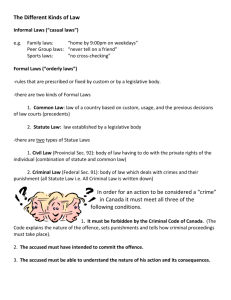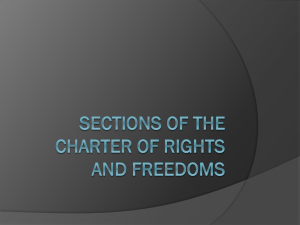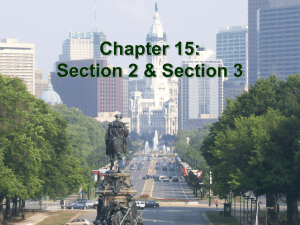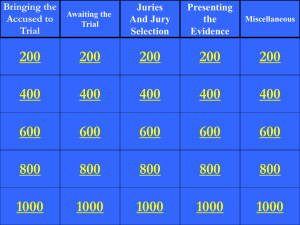R. v. St-Onge Lamoureux, 2012 SCC 57
advertisement
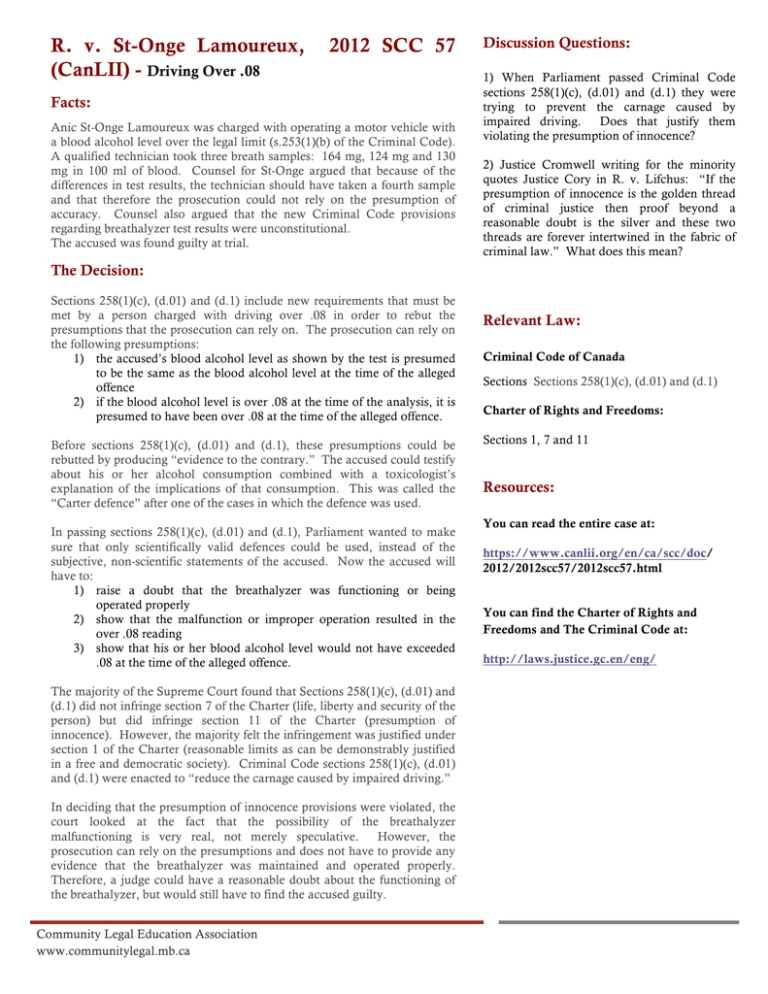
R. v. St-Onge Lamoureux, (CanLII) - Driving Over .08 2012 SCC 57 Facts: Anic St-Onge Lamoureux was charged with operating a motor vehicle with a blood alcohol level over the legal limit (s.253(1)(b) of the Criminal Code). A qualified technician took three breath samples: 164 mg, 124 mg and 130 mg in 100 ml of blood. Counsel for St-Onge argued that because of the differences in test results, the technician should have taken a fourth sample and that therefore the prosecution could not rely on the presumption of accuracy. Counsel also argued that the new Criminal Code provisions regarding breathalyzer test results were unconstitutional. The accused was found guilty at trial. Discussion Questions: 1) When Parliament passed Criminal Code sections 258(1)(c), (d.01) and (d.1) they were trying to prevent the carnage caused by impaired driving. Does that justify them violating the presumption of innocence? 2) Justice Cromwell writing for the minority quotes Justice Cory in R. v. Lifchus: “If the presumption of innocence is the golden thread of criminal justice then proof beyond a reasonable doubt is the silver and these two threads are forever intertwined in the fabric of criminal law.” What does this mean? The Decision: Sections 258(1)(c), (d.01) and (d.1) include new requirements that must be met by a person charged with driving over .08 in order to rebut the presumptions that the prosecution can rely on. The prosecution can rely on the following presumptions: 1) the accused’s blood alcohol level as shown by the test is presumed to be the same as the blood alcohol level at the time of the alleged offence 2) if the blood alcohol level is over .08 at the time of the analysis, it is presumed to have been over .08 at the time of the alleged offence. Before sections 258(1)(c), (d.01) and (d.1), these presumptions could be rebutted by producing “evidence to the contrary.” The accused could testify about his or her alcohol consumption combined with a toxicologist’s explanation of the implications of that consumption. This was called the “Carter defence” after one of the cases in which the defence was used. In passing sections 258(1)(c), (d.01) and (d.1), Parliament wanted to make sure that only scientifically valid defences could be used, instead of the subjective, non-scientific statements of the accused. Now the accused will have to: 1) raise a doubt that the breathalyzer was functioning or being operated properly 2) show that the malfunction or improper operation resulted in the over .08 reading 3) show that his or her blood alcohol level would not have exceeded .08 at the time of the alleged offence. The majority of the Supreme Court found that Sections 258(1)(c), (d.01) and (d.1) did not infringe section 7 of the Charter (life, liberty and security of the person) but did infringe section 11 of the Charter (presumption of innocence). However, the majority felt the infringement was justified under section 1 of the Charter (reasonable limits as can be demonstrably justified in a free and democratic society). Criminal Code sections 258(1)(c), (d.01) and (d.1) were enacted to “reduce the carnage caused by impaired driving.” In deciding that the presumption of innocence provisions were violated, the court looked at the fact that the possibility of the breathalyzer malfunctioning is very real, not merely speculative. However, the prosecution can rely on the presumptions and does not have to provide any evidence that the breathalyzer was maintained and operated properly. Therefore, a judge could have a reasonable doubt about the functioning of the breathalyzer, but would still have to find the accused guilty. 1 Community Legal Education Association www.communitylegal.mb.ca Relevant Law: Criminal Code of Canada Sections Sections 258(1)(c), (d.01) and (d.1) Charter of Rights and Freedoms: Sections 1, 7 and 11 Resources: You can read the entire case at: https://www.canlii.org/en/ca/scc/doc/ 2012/2012scc57/2012scc57.html You can find the Charter of Rights and Freedoms and The Criminal Code at: http://laws.justice.gc.en/eng/ The minority did not feel that the sections infringed either section 7 or 11. Relevant Law: Criminal Code of Canada - Sections 258(1)(c), (d.01) and (d.1) 258. (1) In any proceedings under subsection 255(1) in respect of an offence committed under section 253 or subsection 254(5) or in any proceedings under any of subsections 255(2) to (3.2), (c) where samples of the breath of the accused have been taken pursuant to a demand made under subsection 254(3), if (i) [Repealed before coming into force, 2008, c. 20, s. 3] (ii) each sample was taken as soon as practicable after the time when the offence was alleged to have been committed and, in the case of the first sample, not later than two hours after that time, with an interval of at least fifteen minutes between the times when the samples were taken (iii) each sample was received from the accused directly into an approved container or into an approved instrument operated by a qualified technician, and (iv) an analysis of each sample was made by means of an approved instrument operated by a qualified technician, evidence of the results of the analyses so made is conclusive proof that the concentration of alcohol in the accused’s blood both at the time when the analyses were made and at the time when the offence was alleged to have been committed was, if the results of the analyses are the same, the concentration determined by the analyses and, if the results of the analyses are different, the lowest of the concentrations determined by the analyses, in the absence of evidence tending to show all of the following three things — that the approved instrument was malfunctioning or was operated improperly, that the malfunction or improper operation resulted in the determination that the concentration of alcohol in the accused’s blood exceeded 80 mg of alcohol in 100 mL of blood, and that the concentration of alcohol in the accused’s blood would not in fact have exceeded 80 mg of alcohol in 100 mL of blood at the time when the offence was alleged to have been committed; (d.01) for greater certainty, evidence tending to show that an approved instrument was malfunctioning or was operated improperly, or that an analysis of a sample of the accused’s blood was performed improperly, does not include evidence of (i) the amount of alcohol that the accused consumed, (ii) the rate at which the alcohol that the accused consumed would have been absorbed and eliminated by the accused’s body, or (iii) a calculation based on that evidence of what the concentration of alcohol in the accused’s blood would have been at the time when the offence was alleged to have been committed; (d.1) if samples of the accused’s breath or a sample of the accused’s blood have been taken as described in paragraph (c) or (d) under the conditions described in that paragraph and the results of the analyses show a concentration of alcohol in blood exceeding 80 mg of alcohol in 100 mL of blood, evidence of the results of the analyses is proof that the concentration of alcohol in the accused’s blood at the time when the offence was alleged to have been committed exceeded 80 mg of alcohol in 100 mL of blood, in the absence of evidence tending to show that the accused’s consumption of alcohol was consistent with both (i) a concentration of alcohol in the accused’s blood that did not exceed 80 mg of alcohol in 100 mL of blood at the time when the offence was alleged to have been committed, and (ii) the concentration of alcohol in the accused’s blood as determined under paragraph (c) or (d), as the case may be, at the time when the sample or samples were taken 1 Community Legal Education Association www.communitylegal.mb.ca Charter of Rights and Freedoms 1. The Canadian Charter of Rights and Freedoms guarantees the rights and freedoms set out in it subject only to such reasonable limits prescribed by law as can be demonstrably justified in a free and democratic society. Life, liberty and security of person 7. Everyone has the right to life, liberty and security of the person and the right not to be deprived thereof except in accordance with the principles of fundamental justice. Proceedings in criminal and penal matters 11. Any person charged with an offence has the right (c) not to be compelled to be a witness in proceedings against that person in respect of the offence; (d) to be presumed innocent until proven guilty according to law in a fair and public hearing by an independent and impartial tribunal;
